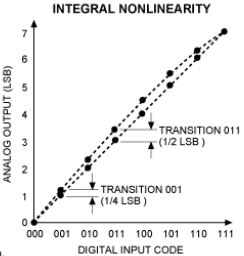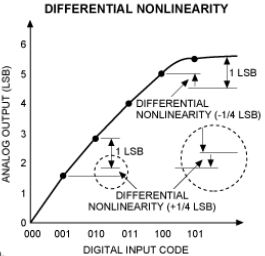As its name implies, non-linearity is the difference between the graph of the input measurement versus actual voltage and the straight line of an “ideal” measurement. The non-linearity error is composed of two components, integral non-linearity (INL) and differential non linearity (DNL). Of the two, integral non-linearity is typically the specification of importance in most data acquisition (DAQ) systems.

INL is the maximum deviation between the ideal output of a DAC and the actual output level (after offset and gain errors have been removed).
INL: The specification is commonly provided in “bits” and describes the maximum error contribution due to the deviation of the voltage versus reading curve from a straight line. Though a somewhat difficult concept to describe textually, INL is easily described graphically and is depicted in Figure 4. Depending on the type of A/D converter used, the INL specification can range from less than 1 LSB to many, or even tens, of LSBs.
DNL: Differential non-linearity describes the “jitter” between the input voltage differential required for the A/D converter to increase (or decrease) by one bit. The output of an ideal A/D converter will increment (or decrement) one LSB each time the input voltage increases (or decreases) by an amount exactly equal to the system resolution.
For example, in a 24-bit system with a 10-volt input range, the resolution per bit is 0.596 microvolt. Real A/D converters, however, are not ideal and the voltage change required to increase or decrease the digital output varies. DNL is typically ±1 LSB or less. A DNL specification greater than ±1 LSB indicates it is possible for there to be “missing” codes. Though not as problematic as a non-monotonic D/A converter, A/D missing codes do compromise measurement accuracy.
Check out UEI’s Master Class Videos on Youtube.

